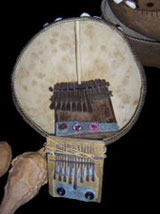
Mbira Music of the Shona People
The Shona people form the largest ethnic group in Zimbabwe. They are also found in parts of Mozambique and Zambia. An important feature of the Shona religion is a strong belief in ancestral spirits. To the Shona people, the death of a person marks only a transition to another plane of existence, and it is important for the living to be in constant touch with these spirits for guidance and for help in times of danger. Categories of ancestral spirits among the Shona include vadzimu (family ancestral spirits), mhondoro (ancestral spirits of chiefs) and makombwe (the guardian spirit of the Shona people). Mbira music provides the most important means to communicate with these ancestral spirits. It is important to note that the word mbira refers to both the music as well as the instrument on which the music is played

Mbira Dzavadzimu in a deze.
Physical Features of the Mbira
The mbira consists of metal strips which are affixed to a wooden resonator and are plucked to produce sounds. Bottle tops or cowry shells, which are also affixed to the sound box, vibrate in sympathy when the metal strips are plucked. The buzzing sounds that are generated from these sympathetic vibrations help to increase the density of sound. One of the most important types of mbira is the mbira davadzimu, an instrument that is associated with spirit possession ceremonies, known as the bira. A bira ceremony is usually organized when the shona need to communicate with their ancestors to seek explanations to confounding situations such as an unexplained illness or the outbreak of famine. In the bira ceremony, mbira is played to facilitate spirit possession and open a line of communication between humans and spirits.
Composer: 0
-
"Taireva"
Mbira may be performed indoors as a solo instrument or as part of an ensemble, which may consist of at least two mbira, hosho (calabash shaker), hand claps, and sometimes drums. In outdoor performances, the instrument is usually placed inside a deze, calabash resonator, for greater amplification. Mbira davadzimu typically consists of about twenty-two keys arranged in three rows, two on the left hand side and one on the right hand side. The keys on the left side are played with the thumb of the left hand, while those on the right side are played with the thumb and the forefinger of the right hand. The lower row on the left side consists of the low tones, while the upper row consists of middle range keys. The only row on the right hand side consists of lower as well as high tones. Unlike the Western piano, the low tones of the mbira proceed from the middle of the instrument, and progressively move higher to the left and right of the instrument.





African people made instruments from materials available to them, like wood, gourds, animal horns and skins.





